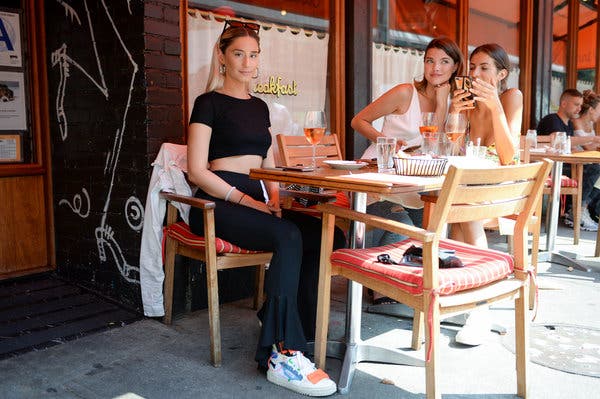
CreditMarcy Swingle for The New York Times
It was hot. So what. Gabrielle Homola ventured out last week on one of summer’s sultriest days dressed from shoulder to shin in densest black.
“I’ve rediscovered the color,” Ms. Homola said. A 25-year-old comedy agent with William Morris Endeavor, she wore a skimpy black ribbed top, slim pants and matching shades. “I’ve noticed a lot of other people have rediscovered it, too,” she said. “Black’s coming up strongly this year.”
Sasha Arnold is another recent convert. “On the streets black has authority,” said Ms. Arnold, 24, an intern at Burberry. “It’s respectable, but at the same time it’s striking. When you’re surrounded by so much color and pattern, it really pops.”
Ms. Homola and Ms. Arnold were but two in a parade of New Yorkers strolling the precincts of NoLIta that day garbed in varying tints of anthracite, jet and ink. The color was no mindless wardrobe fallback but a conscious fashion choice.
No use, though, in calling up hoary clichés. Black is not the new black. We’re not back in black. Black, in fact, has never gone away. It has weathered its share of notoriety, of course, as the color of disaffected youth, a kind of urban camouflage, the tonal equivalent of a hoodie and shades.
It remains the aggressively subversive garb of street toughs, bikers and Goths. And it has survived simultaneously as the reliable uniform of fashion’s old guard, Carine Roitfeld, Grace Coddington and Tonne Goodman among its staunchest devotees.
But as a badge of chic, black’s stature had diminished, consigned to the shade “by an endless stream of candied hues,” as Harling Ross, the fashion director at Man Repeller, the popular fashion site, wrote.
“Millennial pink, Gen-Z yellow, melodramatic purple and Miranda Hobbes green made for great headlines and even greater Instagram feed,” she argued.
That has changed. Wearing black is no longer just a way of keeping one’s head down, remaining noncommittal or retreating behind a wall of neurotic self-doubt.
“When I’m walking in SoHo or the meatpacking district, if I notice someone in head-to-toe black, it’s more than O.K. — it suddenly looks right,” said Sharon Graubard, the founder and creative director of MintModa, a trend forecasting firm. “Black is a statement now.”
She chalked up the color’s renewed impact to a welter of factors, not least its longtime affiliation with beatniks, punks and other misfits, tribes that are being revisited in the popular culture.
Among younger consumers, black conjures an aura of 1990s-inflected insolence, and with it, “the whole Helmut Lang moment,” Ms. Graubard said, referring to the fashion renegade turned artist whose early designs are being reworked and revisited time and again.
Besides, she said, “what could be more iconic than a little black turtleneck with pants and a biker jacket, very early Kate Moss.”
Black may also be an outgrowth of the gender-fluid movement, she suggested. It puts a spotlight on your individuality, not your gender identification.
Most significant, black offers a respite from the sea of raucous color and pattern that has flooded the market of late, its renewed popularity a silent rebuke to a legion of self-promoting social media stars flogging color on their feeds. “After all that crazy selfie wear, what you want to see is black,” Ms. Graubard said.
As a trend, if it can indeed be called a trend, black has legs, its relevance boosted by a cluster of celebrities — among them, Beyoncé and Solange Knowles and the group En Vogue — flaunting black on black at concerts and public outings.
Black, it is also worth noting, made a decisive impact in the fall collections at Alexander McQueen, Dior, Hermès and Rick Owens, who told Vogue, “I felt like I needed some grim, determined glamour.”
And black injected a subversive note into a flurry of high-end fall advertising campaigns. Flanked by a pair of gem-tone frocks on a current Nordstrom billboard, a black dress looks commanding. Black flaunts its authority in two Zara campaigns, Back to Minimal, largely founded on black coats and trousers, and Punk 2.0, all wispy lace dresses and puff-shoulder tops.
Black is a standout in a Giorgio Armani ad that highlights a trim jacket and high-waist jodhpurs, and it asserts itself on the model Anja Rubik in a Saint Laurent campaign.
Its real-life reach, however improbably, extends well beyond the confines of Manhattan. “In Miami, black had not even been considered a color,” said Elysze Held, a stylist, personal shopper and contributing stylist at The Miami Herald. But now, on the street, especially in the Wynwood area, home to a flourishing gallery scene, “black is a signifier of ultimate cool,” Ms. Held said.
At high-profile gatherings, even those of her clients who once shied away from this most somber of hues are changing their tune.
“When they want to stand out in a crowd of Dolce, Pucci and Gucci,” she said, “they wear black.”







